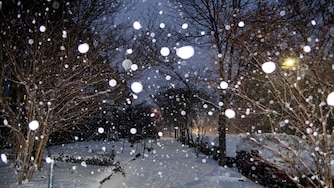To most Baltimore residents, the red brick wall that bordered the old Northwood Plaza shopping center and extended partway up Hillen Road was just that — a wall. An old, crumbling wall, covered in graffiti, that has deteriorated over the years and has become an eyesore in the northeast Baltimore community. But for Morgan State University, the wall was a painful reminder of the hate against Black people that’s all too familiar for historically Black colleges.
As of Tuesday morning, the wall — which became known as the “spite wall” — that was built on hate and oppression was reduced to rubble, symbolizing that Morgan is moving forward, as president David Wilson put it.
“Hate comes tumbling down,” Wilson said as he watched an excavator demolish the remnants of the wall. For Wilson, who has been university president for 13 years, the wall coming down is Morgan’s way of revisiting a not-so-glorious history.

“Morgan is an institution that is not afraid to dig into the past and to unearth those things that are unpleasant and to make sure that they are never forgotten,” Wilson said.
More than 80 years ago, the spite wall was built by white residents to keep the Black students attending what was then Morgan State College out of the white neighborhood and shopping center directly across the street, Wilson said. It was one part of the resistance against Morgan, as Baltimore adopted racial covenants throughout the city.
According to Morgan State historian and alumnus Edwin Johnson, the institution has been in a number of locations, including 44 East Saratoga St. in downtown Baltimore, where it was a part of a thriving Black community in the late 1800s known as Gallows Hill. However, everything in the area was razed after being declared a “slum” by then-Mayor James Preston, with the exception of Mercy Hospital.

Morgan branched out to other locations before finally purchasing property in 1917 in Lauraville, which was part of Baltimore County at the time.
The new site for the college, at the corner of Hillen and Grindon (now Cold Spring Lane), came with some challenges.
“We spent six to nine months in court trying to fight off the surrounding neighborhood associations who were trying to get us evicted from the site because this was a white Christian community who didn’t want Blacks here,” Johnson said. “We were simply unwanted.”
In 1919, the college completed construction on Carnegie Hall, its first building at the Hillen Road location. Morgan College became a public, state school in 1939, at a time when Maryland would not allow Black students to go to white institutions.
As the years went on, Morgan continued to build and expand the campus, including into parts of the Northwood Plaza shopping center, where over 70 years ago Morgan State students held protests for integration of the complex during the Civil Rights Movement.

Wilson’s hope is that students will understand the significance of that history.
“I think our students will know when they come on to these grounds, that they are walking onto hallowed grounds. These same grounds are the grounds students like them protested on,” Wilson said. “Our students will understand they come from a long line of students who said, ‘No, we are not going to become second class to anybody.’”
The spite wall coming down is part of that expansion and marks a turning point for the neighboring community and Morgan State, according to Bridgette Neal, president of the Hillen Road Improvement Association.
Neal said she considers Morgan a community partner and is happy to see the spite wall come down.
“We are definitely excited and finally glad to see this wall come down. It’s held us apart from each other for years, unnecessarily, so we are glad to see our homes be embraced by Morgan State,” Neal said.
Wilson said the university has made a pledge that a portion of the spite wall remain on Hillen Road. He said he has asked the School of Architecture and Planning to make sure that it is preserved and never forgotten.





Comments
Welcome to The Banner's subscriber-only commenting community. Please review our community guidelines.